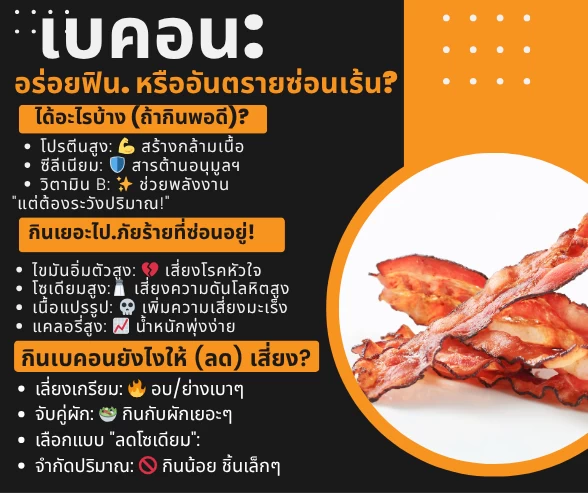
หน้าหลัก | สุขภาพดี | สุภาพสตรี | การแปลผลเลือด | โรคต่างๆ | ยารักษาโรค |วัคซีน | อาหารเพื่อสุขภาพ
เบคอน: ข้อมูลโภชนาการ ประโยชน์ ผลเสีย และวิธีจัดการอย่างชาญฉลาด
เบคอน หนึ่งในอาหารยอดนิยมที่มีกลิ่นหอมและรสชาติที่เป็นเอกลักษณ์ มักถูกนำมาใช้ประกอบอาหารหลากหลายเมนู ไม่ว่าจะเป็นอาหารเช้า อาหารกลางวัน หรือแม้แต่มื้อเย็น อย่างไรก็ตาม เบคอนก็มีทั้งด้านดีและด้านที่ควรระวัง หากรับประทานอย่างไม่ถูกต้อง เรามาเจาะลึกข้อมูลเกี่ยวกับเบคอนกันค่ะ
ข้อมูลโภชนาการของเบคอน
เบคอนส่วนใหญ่ทำจากเนื้อหมูสามชั้นที่ผ่านการแปรรูป หมักเกลือรมควัน และหั่นเป็นชิ้นบาง ๆ ข้อมูลโภชนาการอาจแตกต่างกันไปขึ้นอยู่กับยี่ห้อ วิธีการเตรียม และส่วนของเนื้อหมูที่นำมาใช้ แต่โดยทั่วไปแล้ว เบคอน 3 ชิ้น (ประมาณ 30 กรัม) จะมี:
-
พลังงาน: ประมาณ 120-160 แคลอรี่
-
โปรตีน: ประมาณ 9-12 กรัม
-
ไขมัน: ประมาณ 10-14 กรัม (ส่วนใหญ่เป็นไขมันอิ่มตัว และอาจมีไขมันทรานส์เล็กน้อยหากผ่านกระบวนการบางอย่าง)
-
โซเดียม: ประมาณ 300-500 มิลลิกรัม (ปริมาณสูงมาก)
-
คอเลสเตอรอล: ประมาณ 25-35 มิลลิกรัม
-
วิตามินและแร่ธาตุ: มีวิตามิน B บางชนิด เช่น วิตามิน B1, B2, B3, B12 และแร่ธาตุอย่างซีลีเนียมและสังกะสี แต่ปริมาณไม่สูงมากเมื่อเทียบกับอาหารประเภทอื่น

ประโยชน์ต่อสุขภาพ (ในปริมาณที่เหมาะสม)
แม้ว่าเบคอนจะมีไขมันและโซเดียมสูง แต่ก็ยังมีประโยชน์บางประการหากบริโภคในปริมาณที่จำกัดและเป็นส่วนหนึ่งของอาหารที่สมดุล:
-
แหล่งโปรตีน: เบคอนเป็นแหล่งโปรตีนที่ดี ซึ่งจำเป็นต่อการสร้างและซ่อมแซมกล้ามเนื้อ เนื้อเยื่อ และเอนไซม์ต่าง ๆ ในร่างกาย
-
อุดมไปด้วยซีลีเนียม: ซีลีเนียมเป็นแร่ธาตุสำคัญที่มีฤทธิ์เป็นสารต้านอนุมูลอิสระ ช่วยปกป้องเซลล์จากความเสียหาย และสนับสนุนการทำงานของต่อมไทรอยด์
-
มีวิตามิน B: วิตามิน B ต่าง ๆ มีบทบาทสำคัญในการผลิตพลังงานของร่างกาย และการทำงานของระบบประสาท
-
ความอร่อยและช่วยให้อิ่ม: รสชาติของเบคอนสามารถเพิ่มความน่ารับประทานให้กับมื้ออาหาร และโปรตีนกับไขมันยังช่วยให้รู้สึกอิ่มนานขึ้น
ผลเสียต่อสุขภาพที่ควรระวัง
การบริโภคเบคอนในปริมาณมากหรือบ่อยครั้ง อาจส่งผลเสียต่อสุขภาพได้หลายประการ:
-
ความเสี่ยงโรคหัวใจและหลอดเลือด: เบคอนมีไขมันอิ่มตัวและคอเลสเตอรอลสูง ซึ่งหากบริโภคมากเกินไปอาจเพิ่มระดับคอเลสเตอรอลชนิดไม่ดี (LDL) ในเลือด และเพิ่มความเสี่ยงของโรคหัวใจและหลอดเลือด
-
ความดันโลหิตสูง: ปริมาณโซเดียมที่สูงมากในเบคอนเป็นปัจจัยสำคัญที่ทำให้เกิดความดันโลหิตสูง ซึ่งเป็นสาเหตุหลักของโรคหัวใจ โรคหลอดเลือดสมอง และโรคไต
-
ความเสี่ยงมะเร็ง: เบคอนเป็นเนื้อสัตว์แปรรูป ซึ่งองค์การอนามัยโลก (WHO) จัดให้อยู่ในกลุ่ม 1 (Group 1) หมายถึง "สารก่อมะเร็งในมนุษย์" โดยเฉพาะอย่างยิ่งมะเร็งลำไส้ใหญ่และทวารหนัก สารไนเตรต/ไนไตรต์ที่ใช้ในการแปรรูปอาจเปลี่ยนเป็นสารก่อมะเร็ง (ไนโตรซามีน) เมื่อถูกความร้อนสูง
-
น้ำหนักเพิ่มขึ้น: ด้วยปริมาณแคลอรี่และไขมันที่ค่อนข้างสูง การบริโภคเบคอนบ่อยครั้งอาจนำไปสู่การเพิ่มน้ำหนักและภาวะอ้วนได้
-
การอักเสบในร่างกาย: การบริโภคอาหารแปรรูปและไขมันไม่ดีในปริมาณมาก อาจกระตุ้นให้เกิดการอักเสบเรื้อรังในร่างกาย ซึ่งเป็นรากฐานของโรคเรื้อรังหลายชนิด
การเก็บรักษาเบคอน
การเก็บรักษาเบคอนอย่างถูกวิธีจะช่วยยืดอายุการเก็บและคงคุณภาพของเบคอนไว้ได้:
-
เบคอนที่ยังไม่เปิดบรรจุภัณฑ์: สามารถเก็บในตู้เย็นได้นานถึงวันหมดอายุที่ระบุไว้บนฉลาก
-
เบคอนที่เปิดบรรจุภัณฑ์แล้ว: ควรเก็บไว้ในภาชนะสุญญากาศ หรือห่อด้วยพลาสติกแรปให้แน่นหนาที่สุด เพื่อป้องกันอากาศเข้าและกลิ่นอาหารอื่น ๆ ปะปน ควรบริโภคให้หมดภายใน 5-7 วัน
-
การแช่แข็ง: หากต้องการเก็บเบคอนไว้นานกว่านั้น สามารถแบ่งเบคอนออกเป็นส่วน ๆ ห่อด้วยฟิล์มถนอมอาหารหรือใส่ในถุงซิปล็อกสำหรับแช่แข็ง แล้วนำไปแช่แข็ง สามารถเก็บได้นาน 1-2 เดือน เมื่อจะนำมาใช้ ควรนำมาละลายในตู้เย็นก่อนนำไปประกอบอาหาร
คำแนะนำเพิ่มเติมเพื่อสุขภาพที่ดีในการบริโภคเบคอน
-
จำกัดปริมาณ: พิจารณาให้เบคอนเป็น "อาหารพิเศษ" ไม่ใช่อาหารหลักที่กินทุกวัน ทานในปริมาณที่น้อยลง
-
เลือกชนิดที่ดีกว่า: หากเป็นไปได้ ลองมองหาเบคอนที่ระบุว่า "ลดโซเดียม" (Low Sodium) หรือ "ไม่เติมไนเตรต/ไนไตรต์" (No Added Nitrates/Nitrites)
-
วิธีปรุง: หลีกเลี่ยงการทอดเบคอนจนกรอบเกรียมหรือไหม้ เพราะอาจทำให้เกิดสารก่อมะเร็งได้ง่ายขึ้น ลองใช้วิธีอบหรือย่างแทน และเทน้ำมันส่วนเกินทิ้งหลังการปรุง
-
จับคู่กับอาหารสุขภาพ: รับประทานเบคอนร่วมกับผักสด ผลไม้ หรือธัญพืชไม่ขัดสี เพื่อเพิ่มใยอาหาร วิตามิน และสารต้านอนุมูลอิสระ ที่จะช่วยลดผลกระทบจากเบคอนได้ เช่น แซนด์วิชเบคอนใส่ผักเยอะ ๆ หรือสลัดที่มีเบคอนโรยหน้าเล็กน้อย
-
ดื่มน้ำให้เพียงพอ: เพื่อช่วยให้ร่างกายขับโซเดียมส่วนเกินออกไป
เบคอนเป็นอาหารที่อร่อยและสามารถเพลิดเพลินได้ แต่อย่างที่เห็นว่ามีทั้งด้านบวกและลบ การทำความเข้าใจและบริโภคอย่างมีสติในปริมาณที่เหมาะสม คือกุญแจสำคัญที่จะช่วยให้คุณได้รับความสุขจากเบคอนโดยไม่ส่งผลเสียต่อสุขภาพในระยะยาวค่ะ
คุณมีคำถามเพิ่มเติมเกี่ยวกับการเลือกซื้อเบคอน หรือสูตรอาหารเพื่อสุขภาพที่มีเบคอนเป็นส่วนประกอบบ้างไหมคะ?
